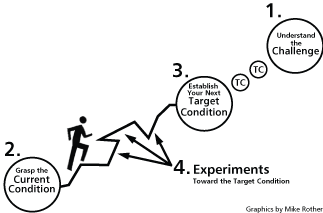OCTOBER 20, 2015 — ARLINGTON, MASSACHUSETTS

successive target condition helps emphasize small, frequent improvements.
Though a single high-performing team can often succeed through the efforts of a few individuals, according to Adam Light, "the organizational challenge increases greatly as complexity increases through the addition of people, functions, and activities. ... As a method for practicing continuous improvement on a day-to-day basis, the improvement kata complements Agile methods and integrates with familiar Lean tools. While applying the scientific method to process improvement is nothing new to those familiar with Six Sigma and similar process improvement methods, breaking improvements down into small parts and implementing those parts using very short planning cycles proves effective for all the same reasons that Agile methods work well in product development and delivery."
A kata is a practice pattern used to develop a set of skills. Leaders at any and every level of an organization can use the improvement kata to practice continuous improvement.1 Following four simple steps (see Figure 1), they:
-
Understand the direction or challenge they are striving for
-
Grasp the current condition using facts and data about current outcomes and the current process
-
Establish a target condition that describes the next step on the way to the challenge
-
Iterate rapidly toward the target condition using small, frequent experiments
Knight continues, "By following the pattern repeatedly, practitioners gradually develop a new mindset as they begin to apply the scientific method to build a deeper understanding of their own work processes, gathering and using data to adapt theories and guide improvements."
* Excerpted from "Managing for Continuous Improvement Using the Improvement Kata and Coaching Kata," (![]() ) Cutter IT Journal Vol. 28, No. 6
) Cutter IT Journal Vol. 28, No. 6

